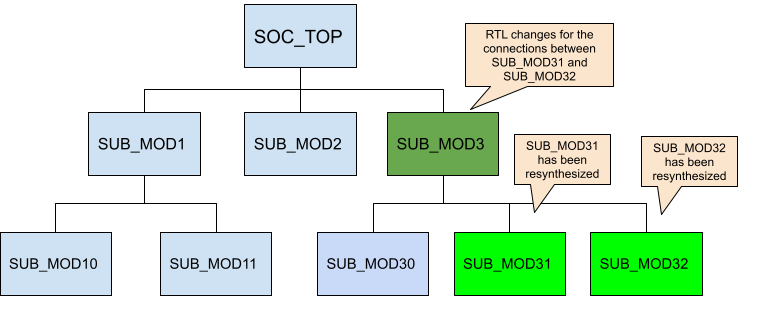Original URL: https://www.linkedin.com/pulse/create-top-level-full-netlist-incrementally-heidi-zheng-gefac
Performing a complete top-level netlist synthesis can be time-consuming. GOF provides APIs enabling the integration of newly synthesized sub-modules into the original pre-layout netlist, along with updates to the top-level SVF file. This incremental approach allows the generation of the large top-level netlist and the top-level SVF file, resulting in significant time and effort savings. At the RTL level, designers identify modified RTL modules during ECO and synthesize them to create netlist and SVF files. Some altered RTL modules, particularly sub-parent modules with only sub-module instantiations, may not require synthesis.
In Figure 1, only two sub-modules, SUB_MOD31 and SUB_MOD32, require re-synthesis in the extensive SOC_TOP design. Their parent module has only experienced connection changes and remains in netlist format, eliminating the need for synthesis. The example below illustrates how to process these files and generate a new SOC_TOP level netlist and SVF file.

Figure 1: Synthesize two sub-modules only
The newly synthesized sub-modules may lack certain ports present in the original netlist. Notably, ports essential for scan in and scan out are typically added by the DFT tool. Since the DFT process is not applied to the new synthesized sub-modules, it's necessary to incorporate these ports as dummy ones within the modules to avoid syntax errors.
The procedure for incorporating DFT ports into the newly synthesized modules is as follows:
use strict;
read_library("tsmc.lib");
read_design("-ref", "SOC_TOP.pre_layout.gv");# Read in the original pre_layout netlist
read_design("-imp", "SUB_MOD31.new_syn.gv");# Read in new netlist
set_tree("ref");
set_top("SUB_MOD31_1"); # The module name to be replaced
my @ref_port_ins = get_ports("-input");
my @ref_port_outs = get_ports("-output");
set_tree("imp");
set_top("SUB_MOD31");
my @imp_port_ins = get_ports("-input");
my @imp_port_outs = get_ports("-output");
my $cnt = 0;
foreach my $port (@ref_port_ins){
if(!grep($port eq $_, @imp_port_ins)){
# The input port is not in the new synthesized module
new_port($port, "-input");
gprint("$cnt: Warning input $port is created\n"); $cnt++;
}
}
foreach my $port (@ref_port_outs){
if(!grep($port eq $_, @imp_port_outs)){
# The output port is not in the new synthesized module
new_port($port, "-output");
gprint("$cnt: Warning output $port is created\n"); $cnt++;
}
}
write_verilog("SUB_MOD31.dft_ports_added.gv");
exit; The identical process should be executed on SUB_MOD32 to include the necessary DFT-related ports.
During this step, the DFT ports added netlist and SVF files of the synthesized sub-modules are read to substitute the original pre-layout netlist and SVF files.
The procedure for replacing netlist and SVF:
read_library("tsmc.lib");
read_svf("-imp", "SOC_TOP.pre_layout.svf");
read_design("-imp", "SOC_TOP.pre_layout.gv");
read_sub_module_svf("SUB_MOD31.svf.txt", "-module", "SUB_MOD31_1", "-syn_module", "SUB_MOD31");
read_sub_module_svf("SUB_MOD32.svf.txt", "-module", "SUB_MOD32_1", "-syn_module", "SUB_MOD32");
read_sub_module_netlist("SUB_MOD31.dft_ports_added.gv", "-module", "SUB_MOD31_1", "-syn_module", "SUB_MOD31");
read_sub_module_netlist("SUB_MOD32.dft_ports_added.gv", "-module", "SUB_MOD32_1", "-syn_module", "SUB_MOD32");
read_sub_module_netlist("SUB_MOD3.new.v", "-module", "SUB_MOD3_1", "-syn_module", "SUB_MOD3", "-sub_only"); # Need sub_only option
replace_sub_module_netlist("SOC_TOP.new_reference.gv"); # Replace netlist should be run first
replace_sub_module_svf("SOC_TOP.new_reference.svf"); # Then replace SVFAfter the generation of both the top-level netlist and SVF files, they can be incorporated into the complete top-level automatic ECO process.
Please visit our website for the original article. NanDigits: Synthesize sub-modules only to create top level netlist incrementally
GOF platform integrates four functional components: ECO, Formal, LEC and Debug. To access detailed information about GOF, please visit the website https://nandigits.com